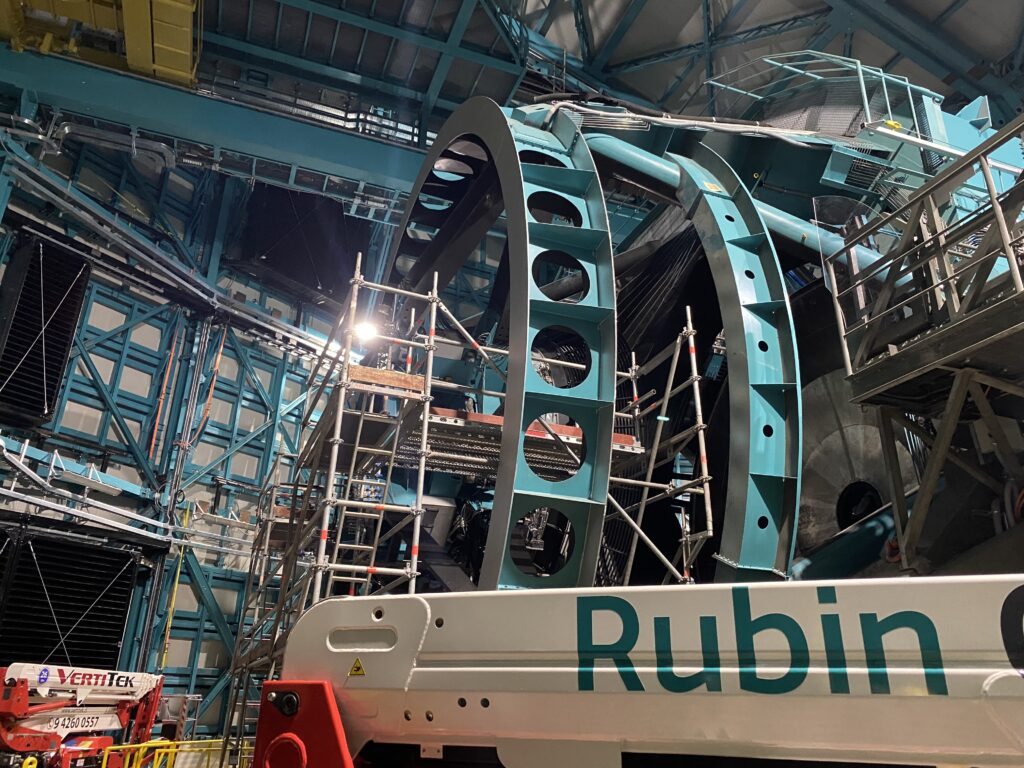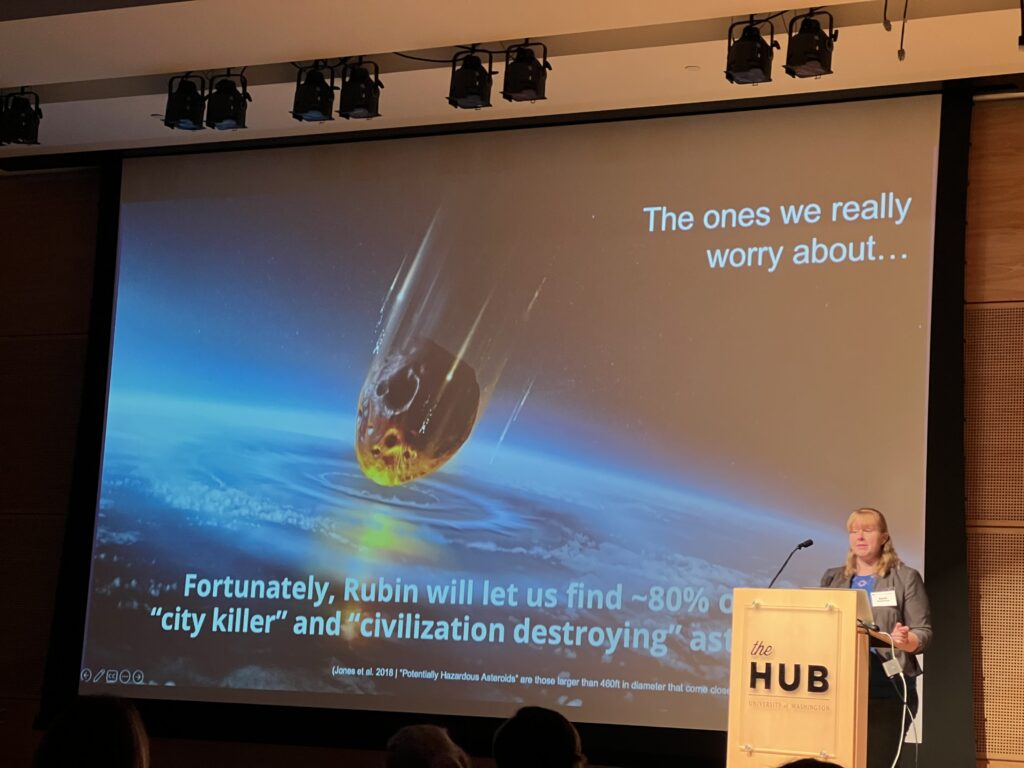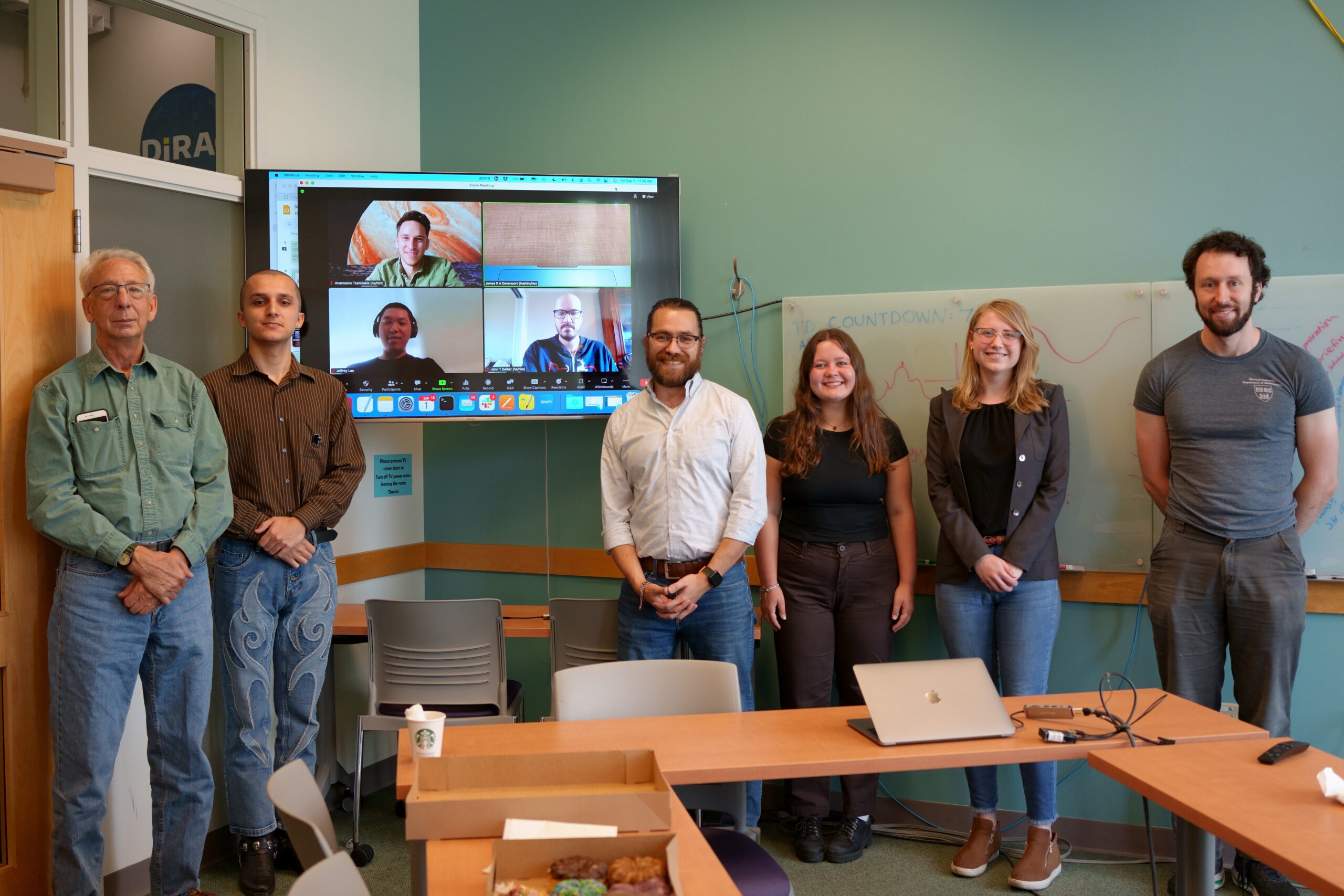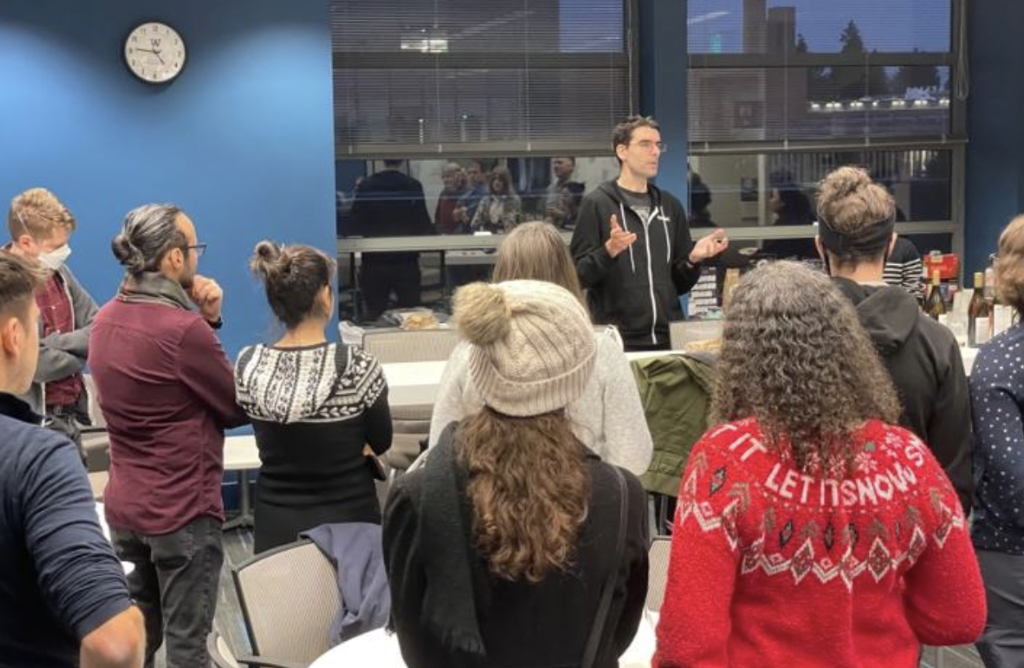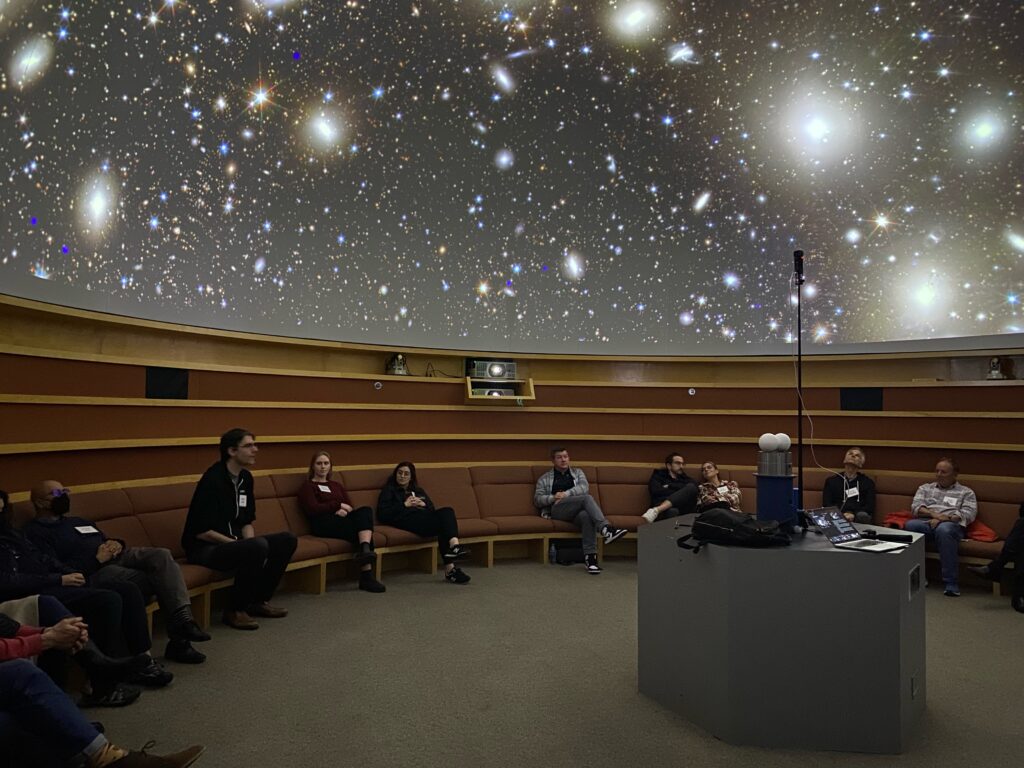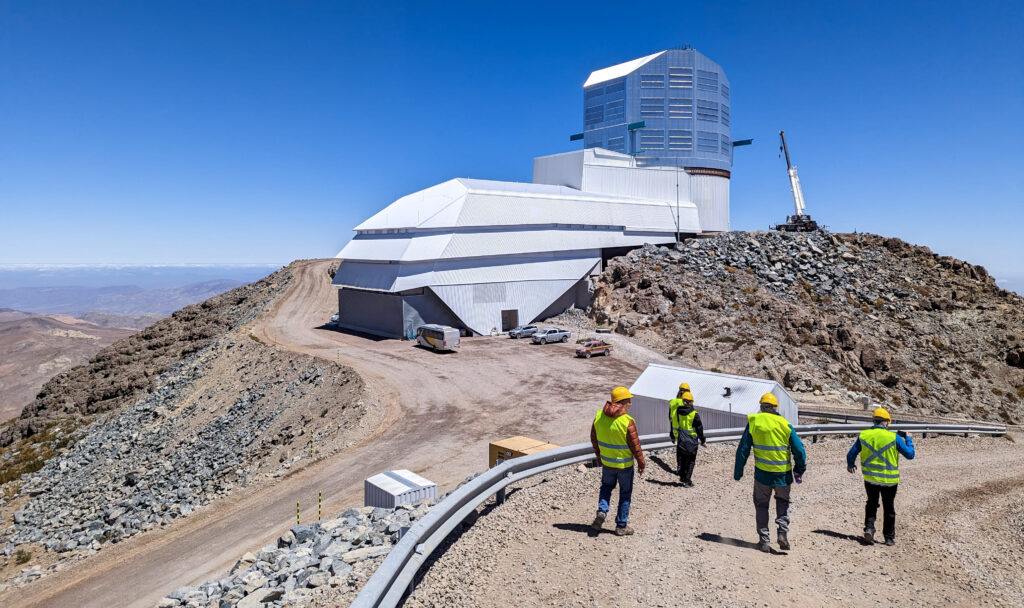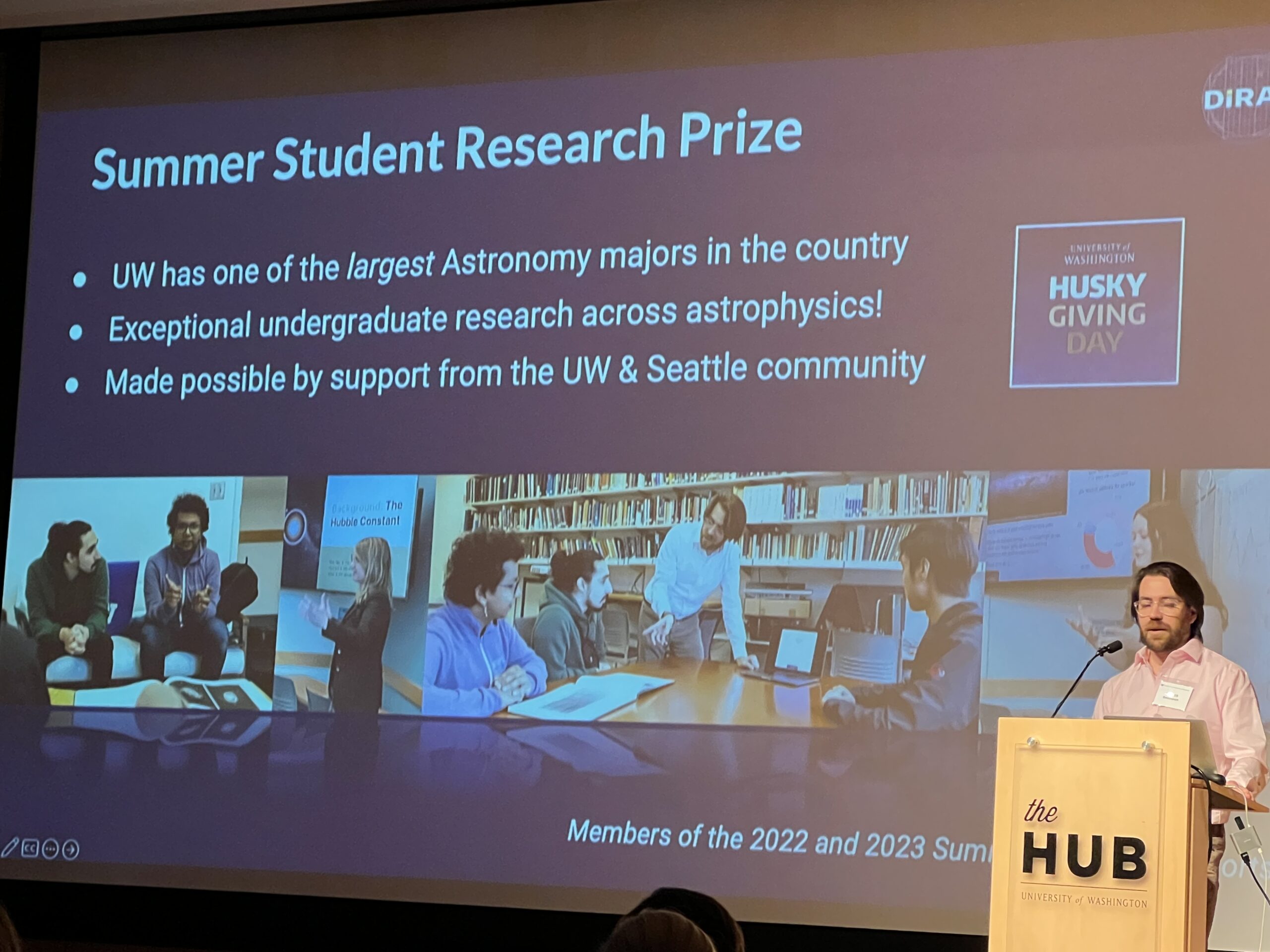The report covers DiRAC’s current impact, highlights in science and personnel, in-depth articles, a review on past and upcoming events, as well as recognizing and celebrating our community’s efforts. Explore the remarkable accomplishments at DiRAC throughout 2023.
Year: 2023
2023 Annual Appeal
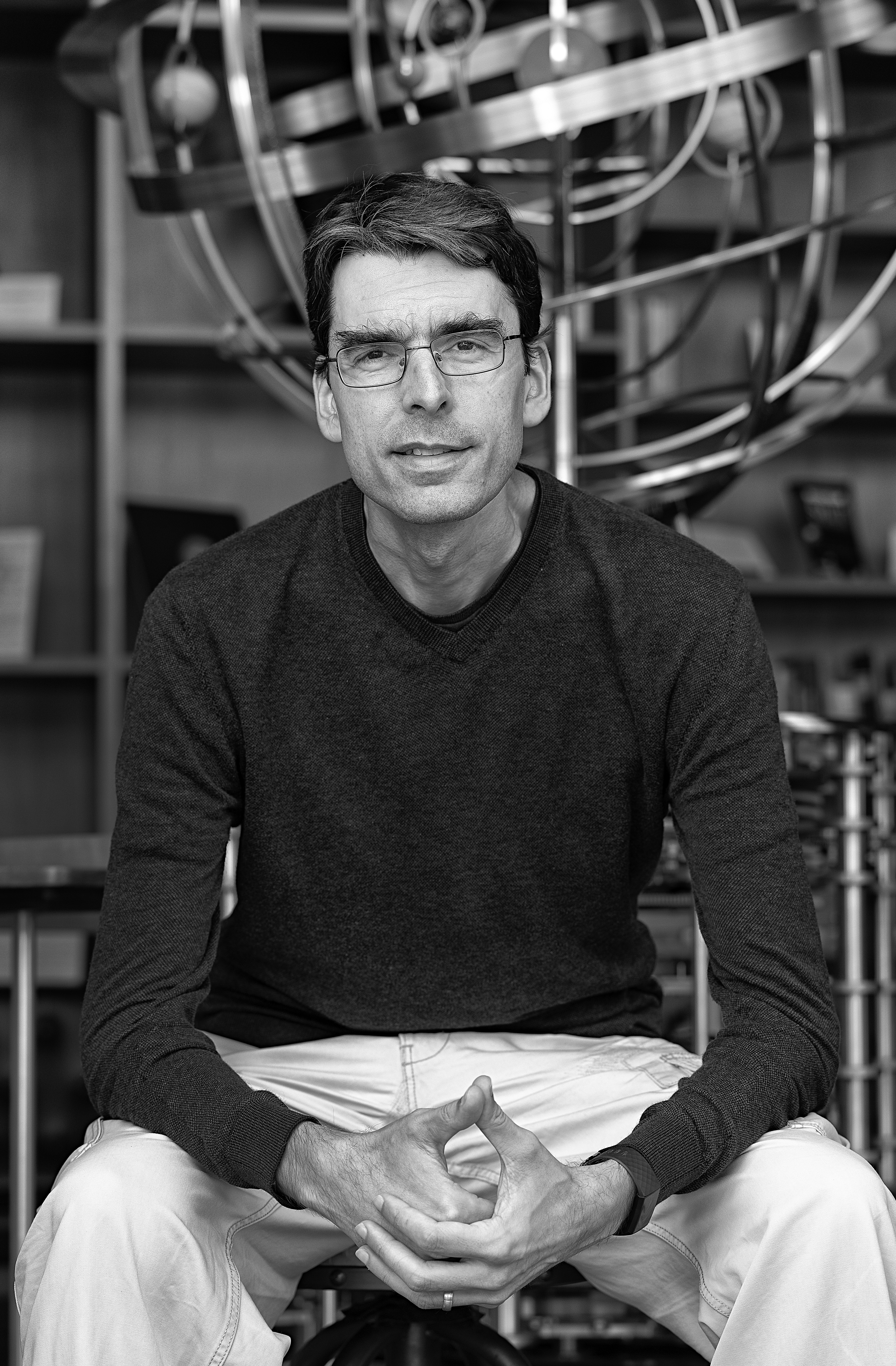
With another year of science behind us, it’s a pleasure to write to you today as the Director of the DiRAC Institute, University of Washington’s hub for research in data-intensive astrophysics and cosmology.
Founded just six years ago thanks to the generous initial support from the Charles and Lisa Simonyi Fund for Arts and Sciences, DiRAC has grown into a truly world-class research institute. In that time, our members co-authored over 500 papers garnering more than 13,000 citations, developed novel algorithms and software powering the next generation of astronomical experiments, all while training the next set of future leaders in astronomy and sharing the excitement of our research with the public.
Throughout 2023 we’ve continued to push towards our vision of a Universe understood through data-intensive discovery. Our team devised and leveraged the immense power of novel algorithms and large datasets to tackle some of the most pressing scientific challenges of our time. We’ve explored the Solar System, from discovering hundreds of distant small bodies in its farthest reaches to finding an elusive asteroid potentially hazardous to Earth. Our students sifted through time-domain data to discover rare stars, and identify strange X-ray sources. We looked at the impact of satellite constellations to Earth-based astronomy, analyzing their effect and ways to enable the co-existence of astronomy and technological progress in an increasingly connected world. And we continue to build and prepare for the science of the once-in-a-generation Rubin Observatory: our teams deployed the critical real-time data analysis pipelines, as well as the first version of novel big data analysis software and formats. I invite you to read more about these and other accomplishments in our Annual Report.
The support we receive from our wonderful community has always been a critical part of DiRAC’s success, and this year was no different. I’m happy to announce that, thanks to a generous donation from Lloyd and Janet Frink, our flagship DiRAC Postdoctoral Fellowship program will continue into 2024. And for the second year in a row, we’ve been able to award Summer Research Prizes, this time to five undergraduate students. This has been made possible by the generous support of David Brooks, Jeff Glickman, our Advisory Board members and numerous individuals. I wish to thank all of our supporters: our students and postdocs would not be able to explore the Universe without you – these accomplishments are yours as much as ours!
Looking ahead, 2024 promises to be incredibly exciting. After over two decades of developing and constructing the Rubin Observatory, we expect to obtain first observations near the end of next year. This observatory will be nothing short of revolutionary: from enabling us to search for new planets in our own Solar System to looking into the farthest reaches of the Universe and understanding the nature of Dark Energy and the Big Bang. A period of unprecedented excitement is before us.
Your gifts to DiRAC will enable our students and researchers to continue bringing these discoveries to the world in 2024. Join and support us on that journey, help us train the next generation of leaders in astronomy, and help make UW the center of the (scientific) Universe!
Sincerely,
Mario Juric
Director, DiRAC Institute
Visit to the Rubin Observatory
In October 2023, our team, members of the DiRAC Advisory Board, and DiRAC’s longtime supporters visited the Rubin Observatory in Chile. It has been an amazing trip! An opportunity to ponder on the terrific achievements from building the structure in the harsh environment to the marvel of engineering. We are excited to look ahead and anticipate discoveries once the Rubin Observatory starts its observations in 2025.
Sign up for the upcoming series of DiRAC events where we will share with the community how this work will change astronomy as we know it today, the local UW involvement and research, and the updates on the Rubin Observatory progress! The event format ranges from the Planetarium Experiences, the Lightning Talks, to the Lab Tours.
A photo gallery with highlights from the Rubin Observatory visit in October 2023 can be found here.
DiRAC Event: Planetarium Experience & Lab Tour
On November 16th, 2023 we would like to invite you to the DiRAC Planetarium Event “A New Era of Discovery: Mapping the Universe with the Rubin Observatory”. The event will take place at the UW Planetarium.
Join us for an evening of discussion and learning with UW astronomers building the largest sky survey in human history. Please reserve your spot here, there are limited number of seats available.
We’re at the brink of a new age of survey-driven discovery in astronomy. Where before we could only study a handful of objects at a time, new detectors, algorithms, and telescopes will soon allow us – and the entire world – to monitor billions.
The flagship of this era will be the Rubin Observatory, set to open in Chile in 2025. Rubin will continuously gather data for over 20Bn stars, 20Bn galaxies, with billions of asteroid observations. In importance, it is a ground-based peer of the Webb space telescope.
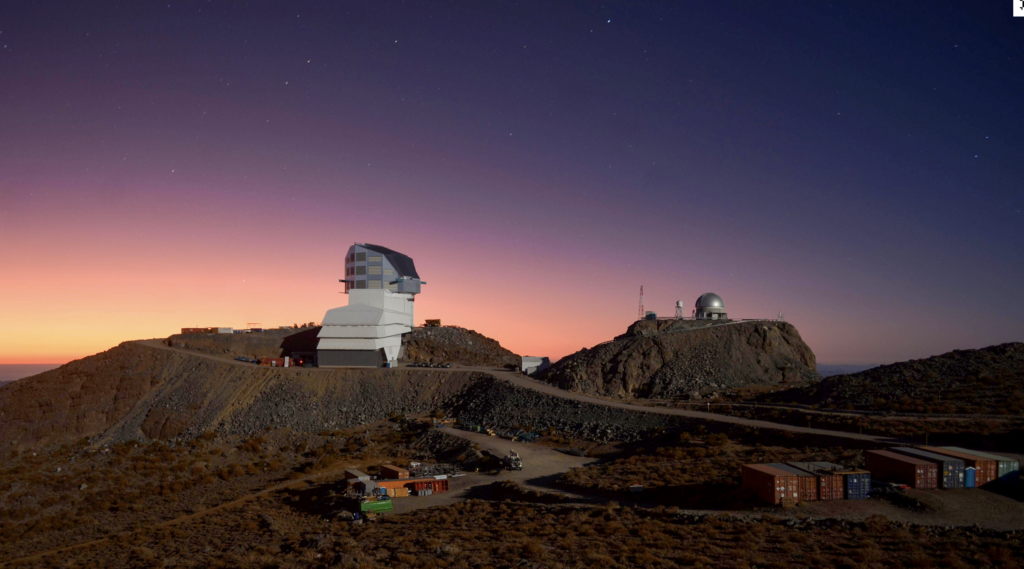
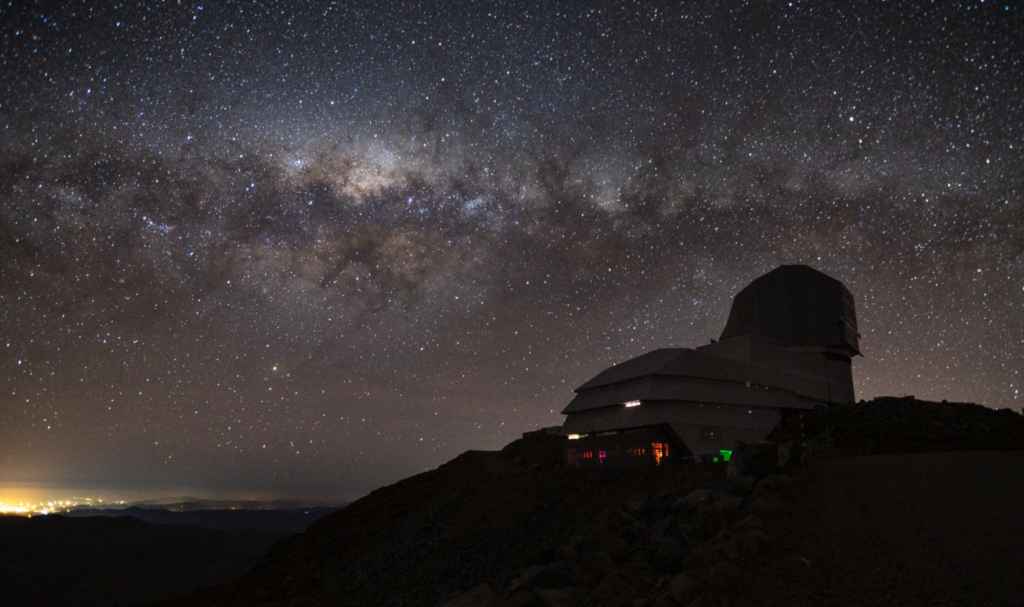
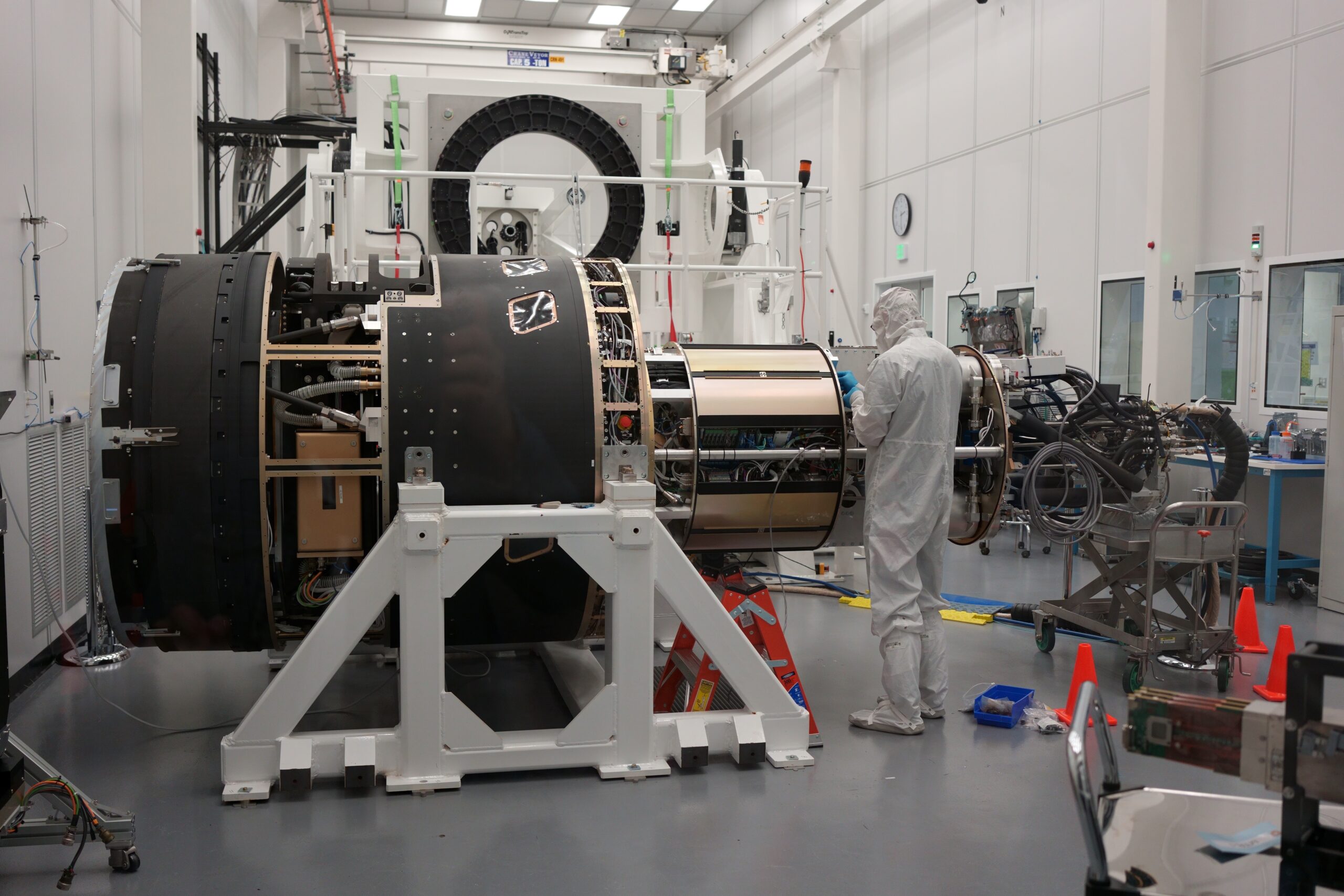
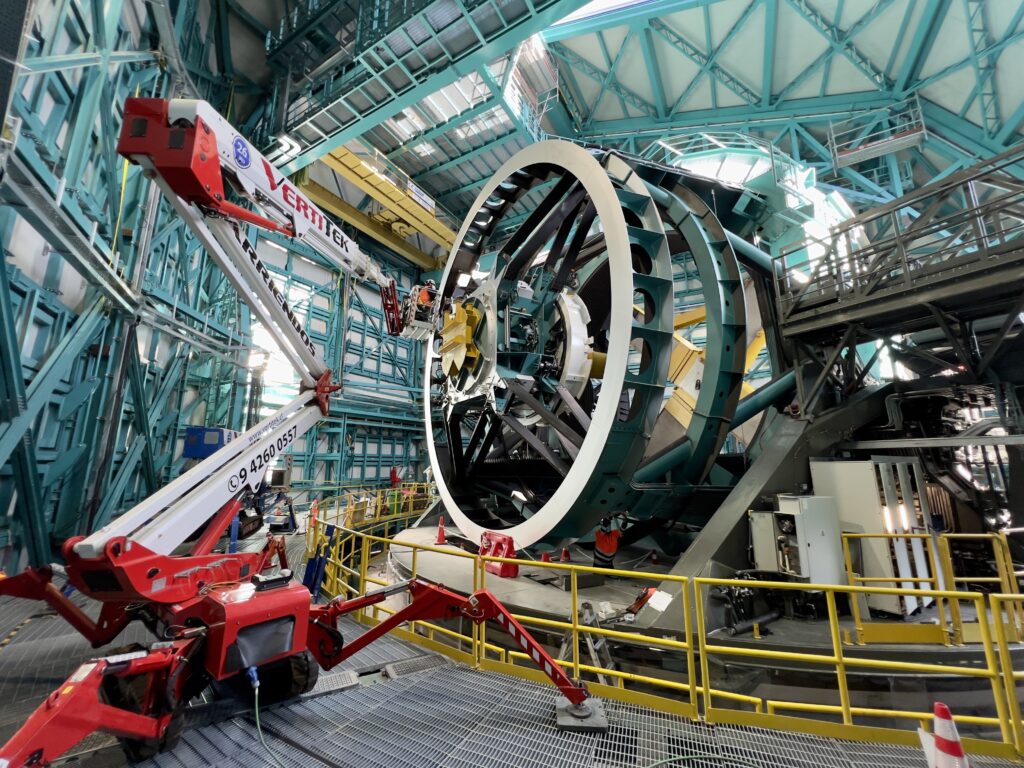
Rubin Observatory network technician Guido Maulen installs fiber optic cables on the Top End Assembly of the telescope mount.
In about a year, DiRAC researchers, students, and citizen scientists will use Rubin to scan the Solar System for hazardous asteroids, discover interstellar comets, and search for new planets in our Solar System. Our codes will map the Milky Way, detect the most energetic explosions in the universe, and help understand Dark Energy. Our students will learn about astronomy by participating in once-in-a-generation wave of discovery. We’re looking forward to sharing this with the community of enthusiasts, friends, and supporters who make DiRAC possible.
Join us at this special event to meet our team, and learn what is to come from the most powerful sky survey telescope ever built!
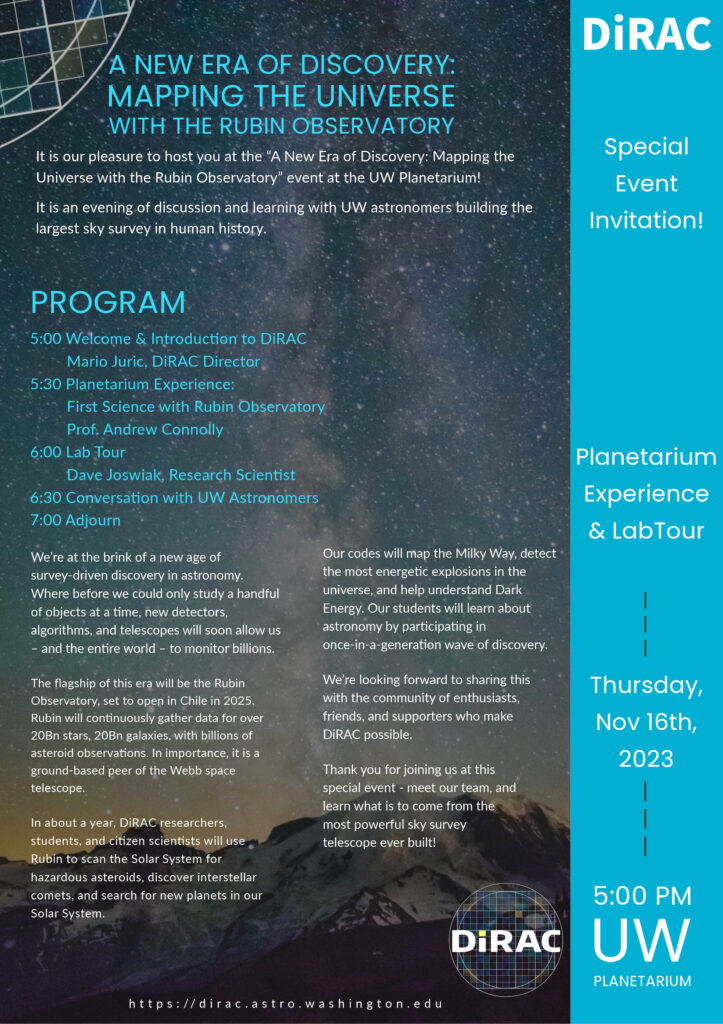
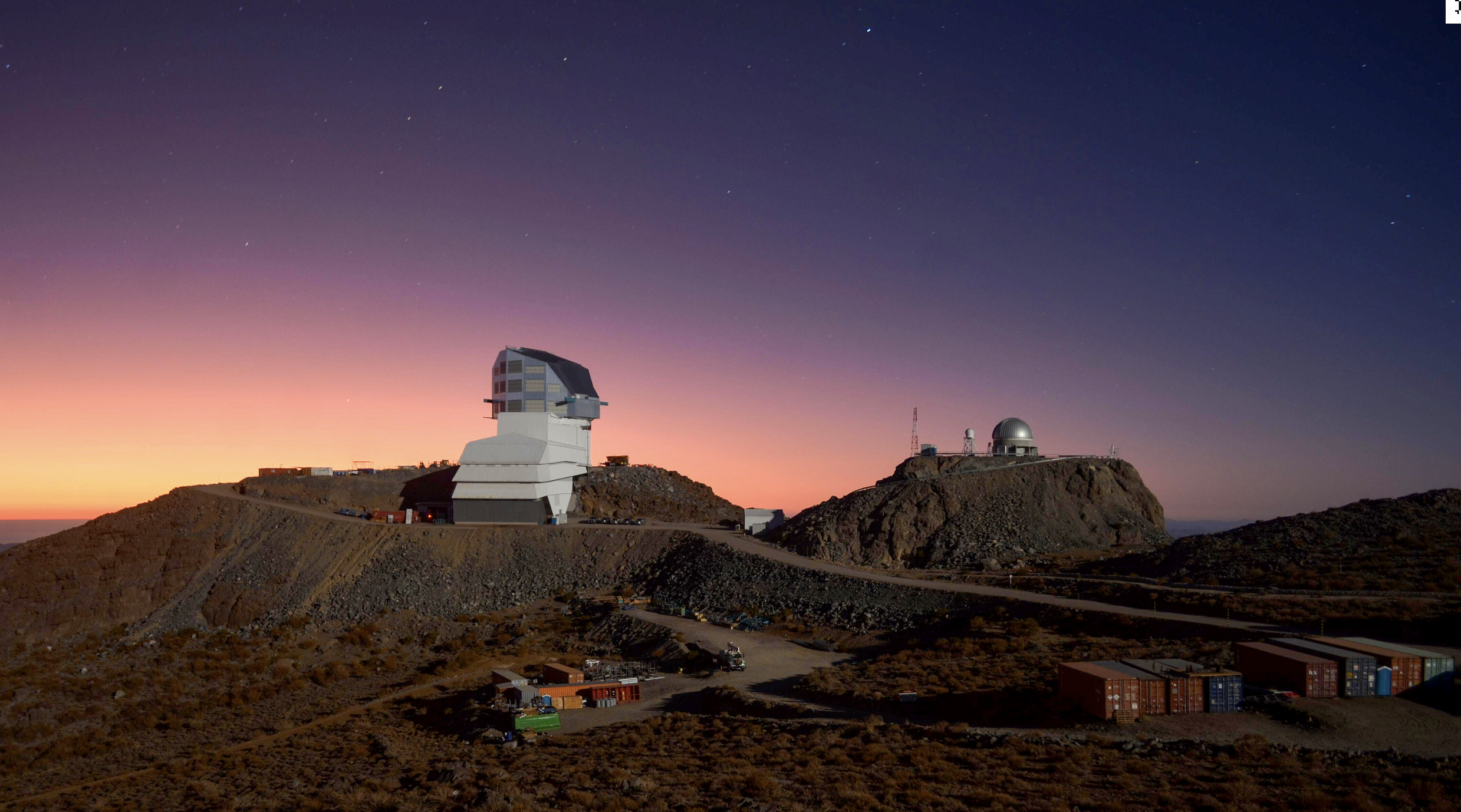
DiRAC Presents at the UW Foundation Board
Last week we were delighted to be able to present in front of the UW Foundation Board at their first meeting of the academic year. Our fearless Director Mario Juric, the newest member of our leadership team Sarah Greenstreet, and myself shared a tiny slice of the incredible work the DiRAC team has produced over the last six years, the excitement we feel with the beginning of Rubin/LSST right around the corner, and a few of the science highlights from our renowned Solar System research group.
This event also allowed us to thank our community of supporters, including and especially Charles and Lisa Simonyi whose gift launched DiRAC and our DiRAC Fellowship program, the many Husky Giving Day donors who have enabled our Summer Research Prize, especially our board members David Brooks and Jeff Glickman, and our colleagues and leadership across the UW and College of Arts and Sciences. The careers launched, discoveries made, and friendships built are all enabled by this support.
After the UW Foundation Board presentation, we were honored to host a deep-dive event for the Directors at the eScience Institute, showcasing the breadth of science happening in the Department of Astronomy. It was a banner day for UW Astronomy and DiRAC, and I’m so grateful to our team for making it happen. A very special thanks to our outreach director, Nikolina Horvat, for making these events happen!
I look forward to welcoming everyone at future events we’re planning, and can’t wait to see what new surprises about the Universe we’ll find this year…
James Davenport
Associate Director, DiRAC
Letter From the Director

Welcome to the September edition of DiRAC’s newsletter!
It’s always a delight to be able to greet and welcome our students, researchers and supporters to the new academic year! For DiRAC, 2024 is shaping to be a big one: from welcoming new postdocs, students, and faculty, to starting to commission the Rubin Observatory in Chile.
This newsletter focuses on news and events that happened over the summer. We hosted the second cohort of Summer Prize recipients, UW astronomy undergraduates working with faculty on a variety of cutting edge projects. Our Rubin team vividly demonstrated the effectiveness of novel asteroid finding algorithms by discovering a new potentially hazardous asteroid previously missed by other surveys. And we were happy to be featured in UW Magazine, with a piece on Rubin accompanied by a beautiful photo of the observatory at night time.
Read more about these and other updates in the rest of this newsletter — not bad for a summer “break”!
Thank you,
Mario Juric
Director, DiRAC Institute
Professor, Department of Astronomy
Student Research Prize Program Successfully Completed
Thanks to the generous support of the DiRAC Advisory Board, and the local UW Astronomy community, the Student Research Prize Program was successfully wrapped up for 2023 this August!
Now in its second year, this prize supports undergraduate research in astronomy at the University of Washington, providing students a stipend to focus on their independent research projects under the supervision of UW faculty and scientists. Previous winners of this prize have presented at local and national research conferences, contributed to peer-reviewed publications, and continued on to graduate school. Our summer program has also been featured in the UW College of Arts and Sciences’ Newsletter.
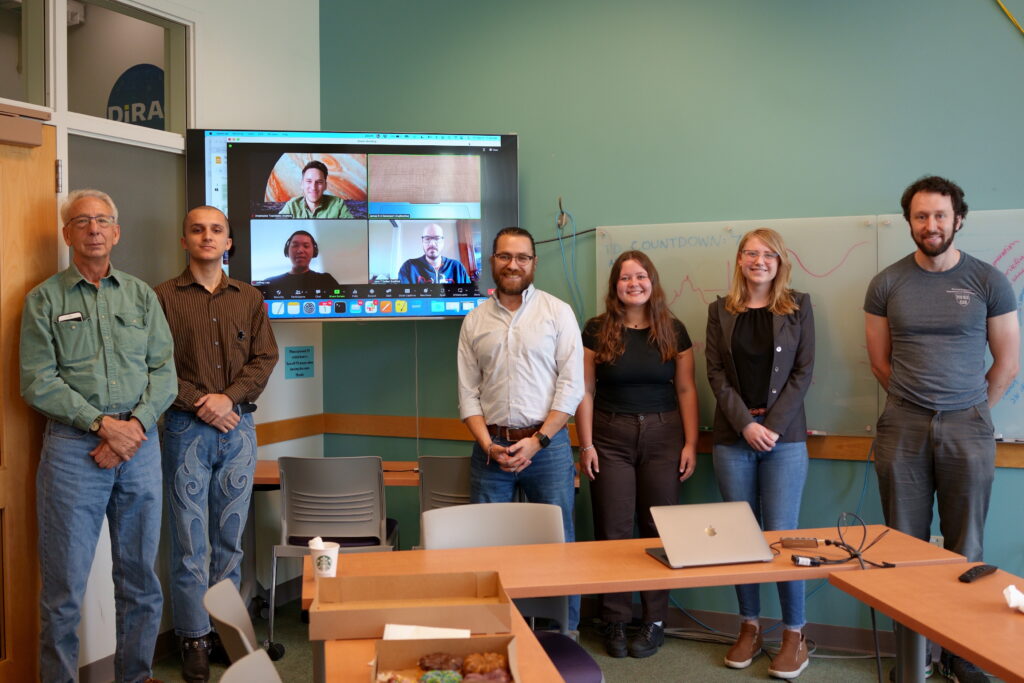
This year we are excited to award 5 summer prizes, including students across a wide range of astronomy and astrophysics research topics:
- Katelyn Ebert (Advisor: Prof. Matt McQuinn): Precision Measurement of the Hubble Constant with Fast Radio Bursts
- John Delker (Advisor: Prof. Andy Connolly): Classifying Transients with ParSNIP
- Celeste Hagee (Advisors: Andy Tzanidakis and Prof. James Davenport): Building a Data-Driven Calibration Model for the Gaia BP/RP Epochal Spectra Using Supernovae
- Bowang Lan (Advisors: Jake Kurlander and Prof. Mario Juric): Investigations with HelioLinC
- Benjamin Herrera (Advisor: Prof. Sarah Tuttle): MARVIN Optimization for Generalized IFU Use
Thank you to the generous community that supports truly excellent student research at the University of Washington, especially our principle donors David Brooks and Jeff Glickman. You are helping the next generation of scholars to build the most advanced datasets, algorithms, and tools to explore and understand the universe!
New Algorithm Discovers ‘Potentially Hazardous’ Asteroid
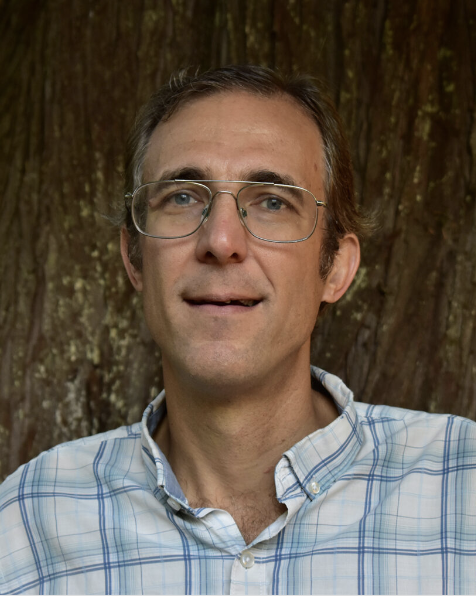
The Vera Rubin Observatory, currently being completed amid the beautiful desolation of the Chilean Andes, is scheduled to begin the most ambitious survey yet of the night sky. Starting in 2025, Rubin will make precise measurements of an estimated forty billion stars and galaxies, most currently unknown. Over ten years of planned operations, Rubin will produce 60 petabytes of data — mapping more than half the sky at a level of detail previously achieved only over small regions.
Rubin is also intended to help protect the earth by discovering thousands of potentially hazardous asteroids too faint for smaller telescopes to detect. In order to survey the cosmos with maximal efficiency, Rubin will take only two images of each patch of sky every night — while currently operating asteroid surveys take four images. Four images are needed to make sure a candidate asteroid is actually real. With only two or three sightings, an asteroid candidate is too likely to be a coincidence of glints from stars or other ‘image junk’, rather than a real object.
Using new algorithms, though, Rubin will be able to combine data from multiple nights, identifying which candidate detections must be real because they line up along a consistent orbital trajectory from night to night. Rubin’s algorithm of choice is based on HelioLinC, invented in 2018 by Smithsonian senior astrophysicist Matt Holman. At the University of Washington, Siegfried Eggl (now a professor at the University of Illinois) and I (Ari Heinze) developed a new version called HelioLinc3D, which uses orbital physics to sort through millions of junk detections and find the real asteroids moving in a consistent way.
HelioLinc3D works great in simulations, but can it discover dangerous near-Earth objects (NEOs) in real life? The most definitive demonstration would be discovering a new NEO in real data from an existing survey — and John Tonry and Larry Denneau, who lead the Hawaii-based ATLAS survey, offered ATLAS data for a test.
To make an actual discovery, HelioLinc3D would have to find something the regular ATLAS software missed — and it doesn’t miss much. I searched archival ATLAS data with HelioLinc3D for weeks, but every NEO I found had been discovered long before. Finally, though, HelioLinc3D flagged the asteroid now designated 2022 SF289. ATLAS had detected this NEO on four different nights — but the object was so faint that it was sighted in only three images on each night — never the four detections required for a single-night discovery. Only a multi-night linking algorithm such as HelioLinc3D could combine the tenuous detections to prove the object was real: the very first NEO ever discovered with the new algorithm.
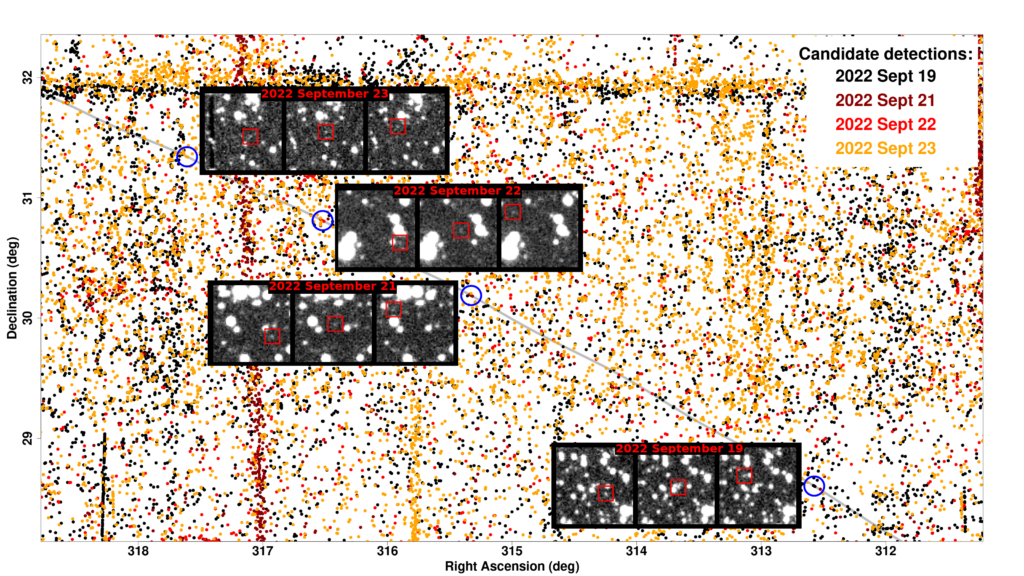
Like other surveys, ATLAS makes millions of candidate asteroid detections every night — thousands even in the small patch of sky shown here. The power of HelioLinc3D is its ability to handle the mathematical complexity of an astrophysical ‘connect the dots’ game in situations like this, where we’re pushing hard to attain sensitivity to the faintest objects and necessarily picking up a lot of ‘image junk’ in the process. In the plot above, four circles highlight the detections of 2022 SF289. In each circle is a tiny string of three overlapping dots — three real detections that look superficially identical to thousands of ‘junk’ detections in the same plot. The fact that measurements from all four nights lie precisely along a consistent orbit — far more precisely than could reasonably occur through random chance — is what proves that the discovery is real.
Only a sophisticated mathematical algorithm like HelioLinc3D could prove that those sets of barely-detectable glimmers all correspond to a single giant rock hurtling through space.
Once the ATLAS observations identified by HelioLinc3D constrained the orbit of 2022 SF289, we knew where to look for some additional detections. Joachim Moeyens, also a researcher at the University of Washington and the B612 Foundation’s Asteroid Institute, identified three images from Caltech’s Zwicky Transient Facility. The Minor Planet Center, the global clearinghouse to which all asteroid discoveries are submitted, identified additional detections from the Hawaii-based Pan-STARRS survey nearly two weeks after the first ATLAS measurements, and later still from the Catalina Sky Survey’s Mt. Lemmon telescope. These additional detections refine our knowledge of 2022 SF289’s orbit and further confirm its reality.
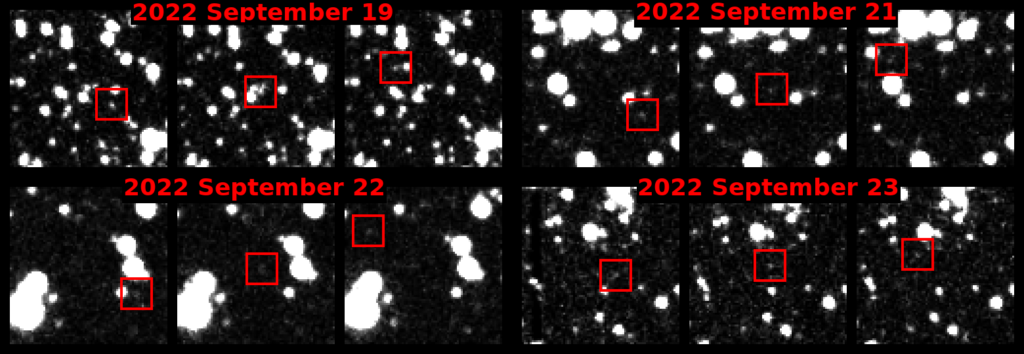
It turns out that 2022 SF289 isn’t just a near-Earth asteroid, it’s a particularly large one (estimated diameter 600 feet) that comes close enough to Earth to be officially designated as a potentially hazardous asteroid, one of about 2350 currently known. It comes within 190,000 miles — less than the distance to the moon — of Earth’s orbit, but 2022 SF289 won’t impact Earth in the foreseeable future. That’s a good thing, since it would explode violently enough to destroy multiple cities if it struck a populated area. The discovery of 2022 SF289 proves that HelioLinc3D can discover potentially hazardous asteroids — not just in simulations but in the real Universe. It’s the strongest possible demonstration that the Vera Rubin Observatory will fulfill its promise of discovering and tracking thousands of new potentially hazardous asteroids. 2022 SF289’s discovery represents another step forward in the ongoing, global effort to defend our planetary home — and even though we call it a potentially hazardous asteroid, the fact that we found it should make us all feel safer.
Written by Ari Heinze
Related Press:
James Urton, UW News – New algorithm ensnares its first ‘potentially hazardous’ asteroid
Robin George Andrews, New York Times – Killer Asteroid-Spotting Software Could Help Save the World
To study the cosmos, scientists manage an astronomical amount of data
BY JAMIE SWENSON | PHOTO BY BRUNO C. QUINT, RUBIN OBSERVATORY
Earlier this month, a beautiful print issue of the UW Magazine featured DiRAC. Here is the article in the digital format.

Related article:
UW Story, Secrets of the Stars
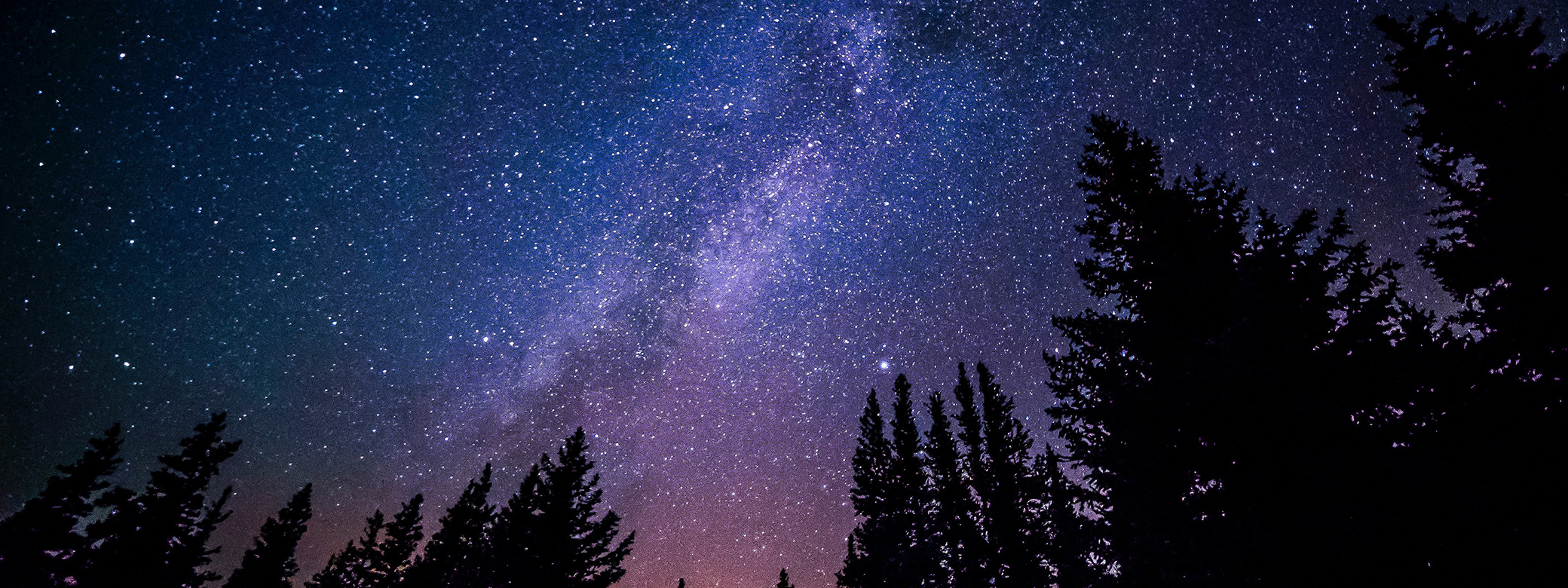
Introducing the 2023 Summer Student Research Prize Winners
Thanks to the generous support of the DiRAC Advisory Board, and the local UW Astronomy community, we are proud to introduce our Student Research Prize Winners for Summer 2023! This prize supports undergraduate research in astronomy at the University of Washington, providing students a stipend to focus on their independent research projects under the supervision of UW faculty and scientists. Previous winners of this prize have presented at local and national research conferences, contributed to peer-reviewed publications, and continued on to graduate school. Our summer program has also been featured in the UW College of Arts and Sciences’ Newsletter.
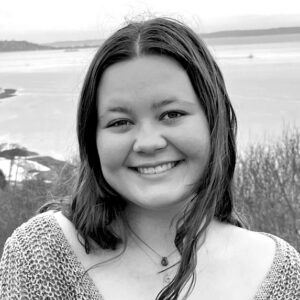
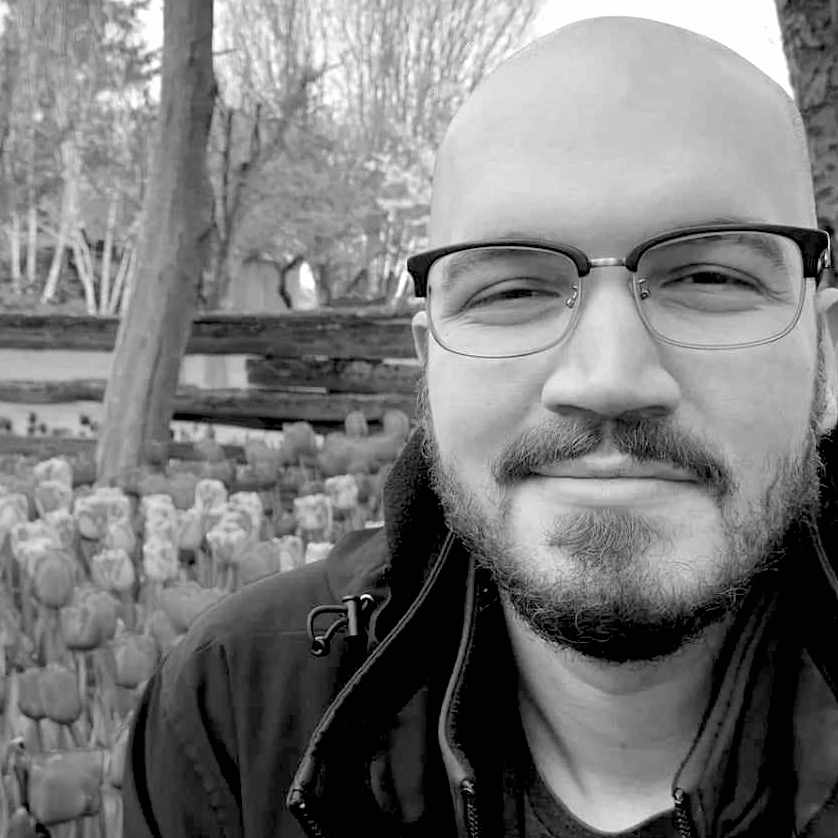
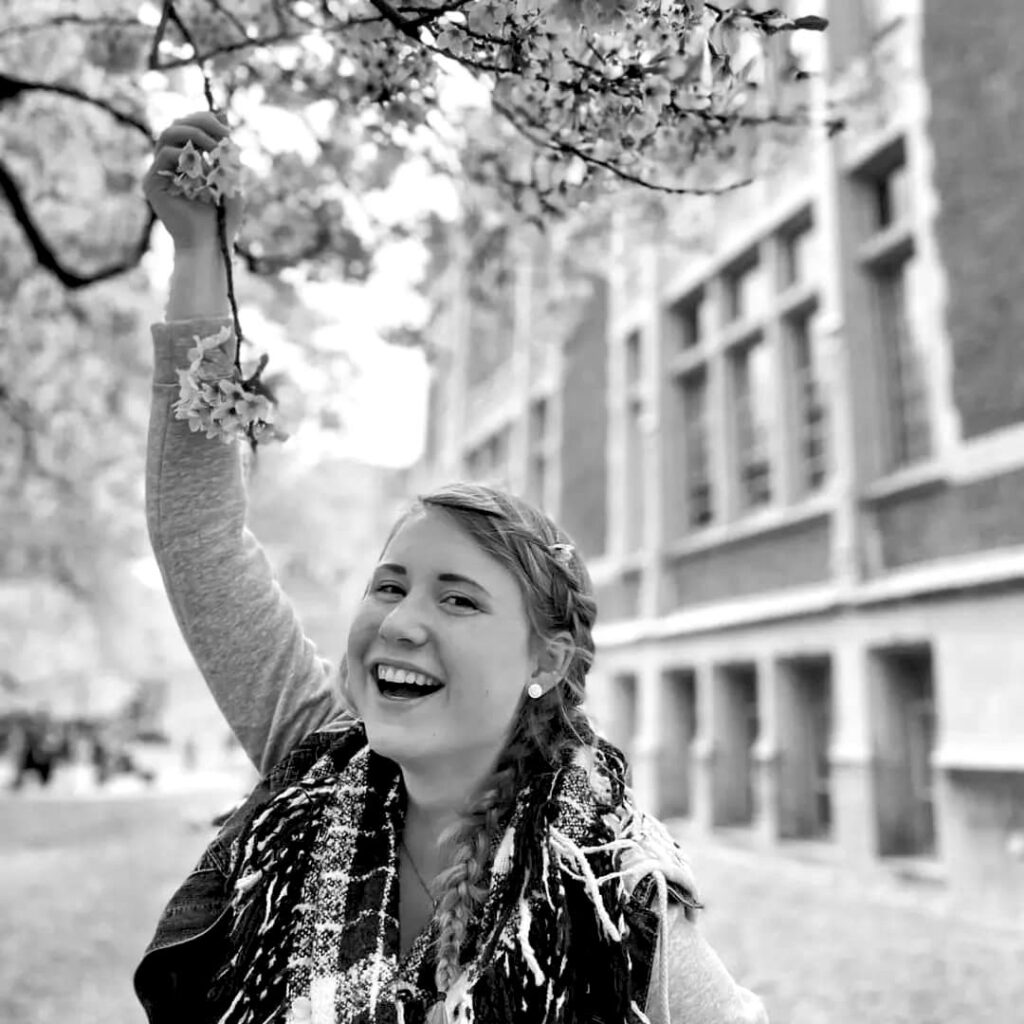
This year we are excited to award 5 summer prizes, including students across a wide range of astronomy and astrophysics research topics:
- Katelyn Ebert (Advisor: Prof. Matt McQuinn): Precision Measurement of the Hubble Constant with Fast Radio Bursts
- John Delker (Advisor: Prof. Andy Connolly): Classifying Transients with ParSNIP
- Celeste Hagee (Advisors: Andy Tzanidakis and Prof. James Davenport): Building a Data-Driven Calibration Model for the Gaia BP/RP Epochal Spectra Using Supernovae
- Bowang Lan (Advisors: Jake Kurlander and Prof. Mario Juric): Investigations with HelioLinC
- Benjamin Herrera (Advisor: Prof. Sarah Tuttle): MARVIN Optimization for Generalized IFU Use
Thank you to the generous community that supports truly stellar student research at the University of Washington, especially our principle donors David Brooks and Jeff Glickman. You are helping the next generation of scholars to build the most advanced datasets, algorithms, and tools to explore and understand the universe!
